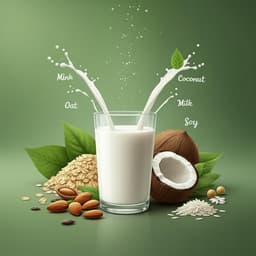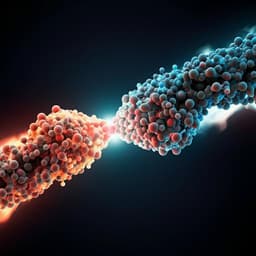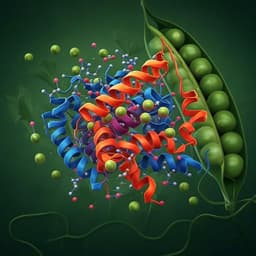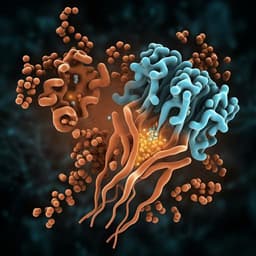
Food Science and Technology
Combined acid hydrolysis and fermentation improves bioactivity of citrus flavonoids in vitro and in vivo
A. König, N. Sadova, et al.
This groundbreaking research by Alice König, Nadiia Sadova, and colleagues explores an innovative method combining acid hydrolysis and fermentation to enhance the bioactivity of citrus flavonoids. By transforming less active glycosides into potent aglycones, the team has significantly improved antioxidant and anti-inflammatory properties, showcasing promising effects in both laboratory and *Drosophila melanogaster* models.
~3 min • Beginner • English
Introduction
The study addresses the limited bioavailability and reduced bioactivity of citrus flavonoids when present as glycosides (e.g., naringin, hesperidin). Glycosylation hinders absorption in the small intestine, shifting metabolism to the colon and diminishing efficacy. The authors hypothesize that converting flavanone glycosides to their aglycones (naringenin, hesperetin) will enhance cellular uptake, transport, and bioactivity. They propose a scalable, food-grade biotransformation strategy combining citric acid hydrolysis (to generate 7-O-glucosides) with lactic acid bacterial fermentation (to cleave glucosides), and evaluate its impact on antioxidant, anti-inflammatory, and intestinal barrier-protective effects using in vitro intestinal and immune cell models and an in vivo Drosophila model.
Literature Review
Prior work shows citrus flavonoids possess antioxidant and anti-inflammatory properties but are poorly absorbed as glycosides. Enzymatic deglycosylation (α-L-rhamnosidase and β-D-glucosidase) can improve bioavailability; a human trial demonstrated improved hesperidin bioavailability after enzymatic modification. Lactic acid bacteria (LAB), including Lactiplantibacillus plantarum, exhibit glycosidase activities and are safe for food/feed, but previous microbial conversions were slow (up to 10 days) with moderate yields. Acid hydrolysis (e.g., HCl) can deglycosylate flavonoids but is less suitable for food applications; citric acid offers a safer alternative. Existing literature documents better cellular uptake/transport for aglycones than glycosides in Caco-2 models, yet the behavior within complex plant matrices is less explored. Evidence in Drosophila supports antioxidant benefits of glycosides (naringin, hesperidin), but aglycone-rich extracts had not been systematically evaluated in vivo for barrier protection and oxidative stress outcomes.
Methodology
Materials: A citrus bioflavonoids complex (>60% flavonoids; main glycosides naringin, neohesperidin, hesperidin) from Citrus aurantium var. amara, C. sinensis, C. paradisi. LAB strains: L. plantarum DSM 20205, Lacticaseibacillus rhamnosus NCTC 10302, Levilactobacillus brevis DSM 6235, Lacticaseibacillus paracasei DSM 20312.
Extract preparation: Non-biotransformed aqueous extract (AQE) prepared as 10% w/w slurry in deionized water, incubated 90°C for 4 h, centrifuged; supernatant retained (≈60% flavonoids dissolved).
Citric acid hydrolysis: Complex (10 g) incubated with 50 ml citric acid (0.25, 0.50, or 1.00 M) at 90°C for 4 h under stirring; sodium citrate added to 100 g final weight. Supernatant after centrifugation designated CAE (final condition selected: 0.25 M citric acid).
Fermentation: LAB cultured in MRS; working fermentations in modified MRS (pH 6.5±0.2). Overnight cultures adjusted to OD600 0.8 (~5×10^8 CFU/ml) in 12 ml modified MRS; 3 ml of AQE or CAE added (mix pH ~5). Incubated at 37°C with agitation. Time course up to 144 h for screening; final condition: L. plantarum for 24 h. Post-fermentation, samples heated (95°C, 10 min) to inhibit enzymes and centrifuged; supernatants used as 100% stock extracts: FermAQE, FermCAE. Controls incubated without bacteria. Co-cultivation tests performed but not superior to L. plantarum alone.
Enzymatic controls: AQE incubated with α-L-rhamnosidase (1 U/ml) or β-D-glucosidase (1 U/ml) at 37°C; sampling up to 120 min; enzyme activity terminated by heat; HPLC-UV quantified flavonoids.
Analytical quantification: HPLC-UV (Vanquish Core; C18 column, 150×3.0 mm, 2.6 µm; 40°C; 10 µl injection; 260 nm); gradient elution with 0.1% formic acid in water/acetonitrile; internal standards for calibration (narirutin, naringin, naringenin-7-O-glucoside, hesperidin, neohesperidin, hesperetin-7-O-glucoside, naringenin, hesperetin). Supernatants dried, reconstituted in DMSO and HPLC solvent; pellets extracted to evaluate precipitated fraction.
In vitro models: Caco-2 (human intestinal), IPEC-J2 (porcine intestinal), and THP-1 (human monocyte-derived macrophages) cell lines.
- Caco-2 uptake: Differentiated monolayers incubated with 2.5% AQE or FermCAE in HBSS for 4 h; cells extracted; aglycones/glycosides quantified by HPLC; protein-normalized uptake.
- Caco-2 transport: Transwell assays (0.4 µm pores); apical 2.5% AQE or FermCAE in HBSS for 4 h; basolateral samples analyzed; TEER measured at 0 and 4 h for integrity.
- Oxidative stress assays (ROS): Caco-2 (AAPH 500 µM) and IPEC-J2 (tBHP 100 µM). Cells co-incubated with H2DCFDA (50 µM) and either pure flavanones (150 µM; naringin, naringenin, hesperidin, hesperetin) or extracts (1.25% or 2.5%); quercetin (20 µM) positive control. ROS kinetics measured and area under curve normalized.
- Cell migration (scratch assay): IPEC-J2 pretreated 6 h with 1.25% extracts; scratch created; challenged with tBHP 100 µM; time-lapse imaging for 420 min; cell front velocity calculated.
- Inflammation (THP-1): PMA-differentiated macrophages stimulated with LPS (250 ng/ml) ± extracts (1.25% or 2.5%) for 24 h. Cytokines profiled by Proteome Profiler array (105 analytes). Selected cytokines (IL-6, CXCL11, CCL7, CXCL9, TNF-α) quantified via Luminex xMAP; also tested pure flavanones.
In vivo model (Drosophila melanogaster, w1118, females): Standardized rearing; groups of ~25 per vial.
- Intestinal barrier challenge: DSS (5%) in liquid diet (5% sucrose, 1% Brilliant Blue) ± AQE or FermCAE (2.5% or 5%) for 7 d; mortality and Smurf phenotype scored daily (n=300/treatment across replicates).
- Oxidative stress: Ferrous iron (FeSO4·7H2O, 30 mM) in sugar-yeast medium ± AQE or FermCAE (2.5% or 5%) for 7 d. After 70 h, homogenates analyzed for ROS (H2DCFDA) and metabolic activity (resazurin), normalized to protein; 7-d mortality and climbing performance (negative geotaxis, 20 s to 5 cm) assessed (n=225/treatment for survival/climbing; n=12 homogenate samples of 25 flies each for biochemistry).
Statistics: Normality by Shapiro–Wilk; parametric ANOVA with appropriate multiple comparisons (Tukey, Dunnett, Šídák) or non-parametric Kruskal–Wallis with Dunn’s test; 95% CI; significance at p≤0.05. Replicate sizes provided per assay.
Key Findings
- Biotransformation efficacy: LAB screening showed all strains cleaved 7-O-glucosides to aglycones, but minimal rhamnoside cleavage over 144 h, indicating β-glucosidase but limited α-rhamnosidase activity. Glucose addition improved growth but reduced β-glucosidase activity.
- Citric acid + fermentation synergy: Citric acid hydrolysis (0.25–1.00 M) increased 7-O-glucosides in a concentration-dependent manner; subsequent 24 h fermentation by L. plantarum maximized aglycone levels. Optimal condition used 0.25 M citric acid for CAE, then L. plantarum fermentation (FermCAE).
- Final extract profiles: FermCAE reached 812 ± 132 µM naringenin and 291 ± 30 µM hesperetin, representing 4.5-fold and 3.1-fold higher than AQE. CAE had the highest 7-O-glucosides (naringenin-7-O-glucoside 638 ± 201 µM; hesperetin-7-O-glucoside 180 ± 40 µM). Precipitated flavonoids in pellets were ≤2.20% of total; aglycones in pellet ≈0.63% in FermCAE.
- Caco-2 uptake/transport: Aglycones exhibited superior uptake versus glycosides from both AQE and FermCAE. Absolute uptake from FermCAE was higher: naringenin 3.26 nmol mg⁻¹ protein vs 0.96 in AQE; hesperetin 0.57 vs 0.25 nmol mg⁻¹. Transport rates: aglycones >32% of the applied dose, glycosides <2%; FermCAE yielded significantly higher basolateral aglycone amounts than AQE (p<0.0001). TEER remained >500 Ω, indicating intact monolayers.
- Antioxidant effects (in vitro): Pure aglycones reduced ROS more strongly than corresponding glycosides. In Caco-2 (AAPH), FermCAE 2.5% reduced ROS by 34% vs AQE at same dose (p<0.0001). In IPEC-J2 (tBHP), hesperetin reduced ROS by 25% vs hesperidin 12% (p<0.0001); FermCAE 2.5% reduced ROS by 37% vs AQE 16% (p<0.0001). Blanks (citric acid or fermentation media without flavonoids) showed no antioxidant effects.
- Cell migration (IPEC-J2): Under tBHP stress, all extracts improved migration vs stressor-only. FermCAE yielded the largest increase in cell front velocity (+2.38 µm h⁻¹, p<0.0001). AQE increased by +1.35 µm h⁻¹ (p=0.0069), not significantly different from FermCAE.
- Anti-inflammatory effects (THP-1): Cytokine arrays showed LPS-induced cytokines (e.g., IGFBP-3, IL-6, IL-17A, CXCL11, CCL2, CCL7, CXCL9, CCL20, osteopontin, RANTES, TNF-α) were reduced by both AQE and FermCAE, with stronger reductions by FermCAE. Luminex quantification confirmed significant decreases in IL-6, CXCL11, CCL7, CXCL9, TNF-α by extracts in a dose-dependent manner; aglycones (naringenin, hesperetin) were more potent than glycosides. Significant differences included naringenin vs naringin for IL-6 (p=0.0042), CCL7 (p=0.0003), TNF-α (p=0.0076); hesperetin vs hesperidin for CCL7 (p=0.0497).
- Drosophila intestinal barrier (DSS): DSS increased mortality and Smurf phenotype. Both extracts (5%) reduced mortality, with greater reduction by FermCAE (14.43% vs 8.61% reduction vs untreated DSS group); Smurf phenotype reduced comparably by 5% AQE and 5% FermCAE (~20% reduction; both p<0.0001).
- Drosophila oxidative stress (Fe2+): ROS in homogenates decreased in a concentration-dependent manner; 5% FermCAE reduced ROS by 64.27% vs stressor-only. FermCAE significantly reduced mortality (2.5% p=0.0252; 5% p<0.0001) and improved climbing performance significantly at 5% (p=0.0019); AQE showed weaker or no significant effects on these endpoints. Metabolic activity suppression under stress was not rescued by treatments.
Overall, increasing aglycone content via citric acid hydrolysis plus LAB fermentation enhanced cellular uptake/transport and improved antioxidant, anti-inflammatory, cell migration, and in vivo protective outcomes compared to non-biotransformed extract.
Discussion
The combined citric acid hydrolysis and L. plantarum fermentation effectively converts citrus flavanone glycosides to their aglycones, thereby enhancing bioavailability as evidenced by greater uptake and transepithelial transport in Caco-2 monolayers. This mechanistic improvement translates to superior functional bioactivities: enhanced antioxidant defense in intestinal epithelial cells, restoration of cell migration under oxidative stress, attenuation of LPS-induced pro-inflammatory cytokines in macrophages, and protection of intestinal barrier integrity and survival in Drosophila under DSS or iron-induced stress. The superiority of aglycones over glycosides aligns with prior findings on uptake and transport of hesperetin/naringenin versus hesperidin/naringin, and the present work extends these observations to complex extract matrices and multiple biological endpoints, including chemokine modulation (e.g., CXCL11, CCL7, CXCL9) not previously reported for flavanones. From a technological perspective, the approach offers a food-grade, sustainable alternative to strong acid treatments or expensive enzyme preparations, achieving 3–4.5-fold aglycone enrichment within 28 h. While matrix and solvent constraints (HBSS) and limited β-glucosidase capacity at higher 7-O-glucoside loads were noted, the process parameters identified provide a balance between hydrolysis efficiency and microbial conversion. The in vivo Drosophila data corroborate in vitro findings and suggest potential translational benefits for intestinal health and oxidative stress resilience, recognizing the role of microbiota in flavonoid metabolism.
Conclusion
This study establishes a practical, food-grade biotransformation method—citric acid hydrolysis followed by 24 h fermentation with Lactiplantibacillus plantarum—to enrich aglycones (naringenin, hesperetin) in citrus extracts, markedly improving cellular uptake/transport and enhancing antioxidant, anti-inflammatory, and intestinal barrier-protective effects in vitro and in vivo. The method yields 4.5-fold (naringenin) and 3.1-fold (hesperetin) increases over aqueous extraction and outperforms non-biotransformed extracts across multiple bioassays. Given its simplicity, cost-effectiveness, and suitability for food/feed applications, this approach is promising for nutraceuticals and functional foods. Future work should optimize enzyme activities (e.g., enhance β-glucosidase without suppressing growth), evaluate whole-fermentation products including pellets and bacterial components, investigate bioavailability in human-relevant gastrointestinal models or clinical studies, and explore applicability to other glycosylated flavonoid-rich botanicals.
Limitations
- Analytical solvent constraints: Uptake/transport assays used HBSS rather than gastrointestinal fluid mimics due to HPLC interference, potentially affecting physiological relevance.
- Enzyme capacity: Higher citric acid concentrations generated more 7-O-glucosides but did not further increase aglycones, indicating limited β-glucosidase activity under conditions used.
- Extract fractionation: Only supernatants (dissolved flavonoids) were tested; minor fractions of precipitation and bacterial biomass were excluded, which may influence real-world applications.
- Model generalizability: In vitro cell lines and Drosophila models do not fully recapitulate human physiology; results require validation in mammalian in vivo models or clinical studies.
- Microbiota influence: Drosophila gut microbiota may have contributed to in vivo deglycosylation/metabolism, complicating attribution of effects solely to pre-formed aglycones.
- Sex/strain specificity: Only female w1118 flies were tested; potential sex- or strain-specific effects were not assessed.
Related Publications
Explore these studies to deepen your understanding of the subject.







